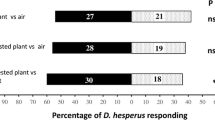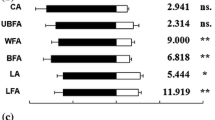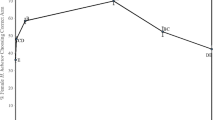Abstract
Females of Cotesia marginiventris(Cresson), a generalist larval parasitoid, were observed to respond to host related odors in a four-arm olfactometer. The females were significantly more responsive to the odors after a brief contact experience with host-damaged leaves contaminated with host by products. During the experience, actual encounters with hosts were not required to improve subsequent responses to host-related odors. The response to odors of the plant-host complex with which parasitoids had experience was significantly higher than the response to odors of an alternative plant-host complex. This suggests that the experience effect is due, at least partly, to associative learning. We suspect that females of this generalist parasitoid, as was recently found for those of a specialist, recognize specific semiochemicals when they contact frass of suitable host larvae. The parasitoids, subsequently, associate the surrounding odors with the possible presence of hosts, and use these odors as cues in their search for more hosts. This could be an important component in the host-searching behavior of many parasitoids.
Similar content being viewed by others
References
Arthur, A. P. (1966). Associative learning inItoplectis conquisitor (Say) (Hymenoptera: Ichneumonidae).Can. Entomol. 98: 213–223.
Arthur, A. P. (1971). Associative learning byNemeritis canescens (Hymenoptera: Ichneumonidae).Can. Entomol. 103: 1137–1141.
Chew, V. (1976). Comparing treatment means: A compendium.Hort. Sci. 11: 348–357.
Dmoch, J., Lewis, W. J., Martin, P. B., and Nordlund, D. A. (1985). Role of the host-produced stimuli and learning in host selection behavior ofCotesia (=Apanteles) marginiventris (Cresson).J. Chem. Ecol. 11: 453–463.
Drost, Y. C., Lewis, W. J., Zanen, P. O., and Keller, M. A. (1986). Beneficial arthropod behavior mediated by airborne semiochemicals. I. Flight behavior and influence of preflight handling ofMicroplitis croceipes (Cresson).J. Chem. Ecol. 12: 1247–1262.
Drost, Y. C., Lewis, W. J., and Tumlinson, J. H. (1988). Beneficial arthropod behavior mediated by airborne semiochemicals. V. Influence of plant characteristics and experience on host-searching behavior ofMicroplitis croceipes (Cresson), aHeliothis parasitoid.J. Chem. Ecol. 14: 1607–1616.
Eller, F. J., Tumlinson, J. H., and Lewis, W. J. (1988). Beneficial arthropod behavior mediated by airborne semiochemicals. II. Olfactometric studies of the host-location by the parasitoidMicroplitis croceipes (Cresson) (Hymenoptera: Braconidae).J. Chem. Ecol. 14: 425–434.
Gross, H. R., Jr., Lewis, W. J., Jones, R. L., and Nordlund, D. A. (1975). Kairomones and their use for management of entomophagous insects. III. Stimulation ofTrichogramma achaeae, T. pretiosum, andMicroplitis croceipes with host seeking stimuli at time of release to improve their efficiency.J. Chem. Ecol. 1: 431–438.
Herard, F., Keller, M. A., Lewis, W. J., and Tumlinson, J. H. (1988). Beneficial arthropod behavior mediated by airborne semiochemicals. IV. Influence of host diet on host-oriented flight chamber responses ofMicroplitis demolitor Wilkinson.J. Chem. Ecol. 14: 1597–1606.
King, E. G., and Leppla, N. C. (1984).Advances and Challenges in Insect Rearing, Agr. Res. Serv., USDA, U.S. Government Printing Office, Washington, D.C.
Lewis, W. J., and Burton, R. L. (1970). RearingMicroplitis in the laboratory withHeliothis zea as hosts.J. Econ. Entomol. 63: 656–658.
Lewis, W. J., and Tumlinson, J. H. (1988). Host detection by chemically mediated associative learning in a parasitic wasp.Nature 331: 257–259.
Lewis, W. J., Nordlund, D. A., and Gueldner, R. C. (1982). Semiochemicals influencing behavior of entomophages: Roles and strategies for their employment in pest control. Les Médiateurs chimiques.INTRA Symp. 7: 225–242.
Loke, W. H., and Ashley, T. R. (1984). Potential use of kairomones for behavioral manipulation ofCotesia marginiventris (Cresson).J. Chem. Ecol. 9: 1377–1383.
Monteith, L. G. (1963). Habituation and associative learning inDrino bohemica Men. (Diptera: Tachinidae).Can. Entomol. 95: 418–426.
Nordlund, D. A., and Lewis, W. J. (1985). Response of females of the braconid parasitoidMicroplitis demolitor to frass of larvae of the noctuids,Heliothis zea andTrichoplusia ni and to 13- methylhentriacontane.Entomol. Exp. Appl. 38: 109–112.
Sandlan, K. (1980). Host location byCoccygomimus turionellae (Hymenoptera: Ichneumonidae).Entomol. Exp. Appl. 27: 233–245.
Steel, R. G., and Torrie, J. H. (1960).Principles and Procedures of Statistics, McGraw-Hill, New York.
Taylor, R. J. (1974). Role of learning in insect parasitism.Ecol. Monogr. 44: 89–104.
Vet, L. E. M. (1983). Host-habitat location through olfactory cues byLeptopilina clavipes (Hartig) (Hym.: Eucoilidae), a parasitoid of fungivorousDrosophila: The influence of conditioning.Neth. J. Zool. 33: 225–248.
Vet, L. E. M. (1985). Response to kairomones by some alysiine and eucoilid parasitoid species (Hymenoptera).Neth. J. Zool. 35: 486–496.
Vet, L. E. M., and van Opzeeland, K. (1984). The influence of conditioning on olfactory microhabitat and host location inAsobara tabida (Nees) andA. rufescens (Foerster) (Braconidae: Alysiinae), larval parasitoids of Drosophilidae.Oecologia 63: 171–177.
Vet, L. E. M., and van Opzeeland, K. (1985). Olfactory microhabitat selection inLeptopilina heterotoma (Thomson) (Hym.: Eucoilidae), a parasitoid of Drosophilidae.Neth. J. Zool. 35: 497–504.
Vet, L. E. M., van Lenteren, J. C., Heijmans, M., and Meelis, E. 1983. An airflow olfactometer for measuring olfactory responses of hymenopterous parasitoids and other small insects.Physiol. Entomol. 8: 97–106.
Vinson, S. B. (1976). Host selection by insect parasitoids.Annu. Rev. Entomol. 21: 109–133.
Vinson, S. B. (1984). Parasitoid-host relationship. In Bell, W. J., and Carde, R. T. (eds.),Chemical Ecology of Insects, Sinauer Associates, Sunderland, Mass., pp. 11–124.
Vinson, S. B., Barfield, C. S., and Henson, R. D. (1977). Oviposition behaviour ofBracon mellitor, a parasitoid of the boll weevil (Anthonomis grandis). II. Associative learning.Physiol. Entomol. 2: 157–164.
Wardle, A. R., and Borden, J. H. (1985). Age-dependent associative learning byExeristes roborator (F.) (Hymenoptera: Ichneumonidae).Can. Entomol. 117: 605–616.
Author information
Authors and Affiliations
Additional information
Mention of a proprietary product does not constitute an endorsement or the recommendation for its use by the USDA.
Rights and permissions
About this article
Cite this article
Turlings, T.C.J., Tumlinson, J.H., Lewis, W.J. et al. Beneficial arthropod behavior mediated by airborne semiochemicals. VIII. Learning of host-related odors induced by a brief contact experience with host by-products inCotesia marginiventris (Cresson), a generalist larval parasitoid. J Insect Behav 2, 217–225 (1989). https://doi.org/10.1007/BF01053293
Accepted:
Issue Date:
DOI: https://doi.org/10.1007/BF01053293




